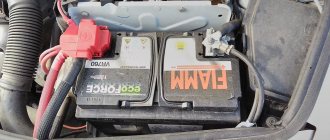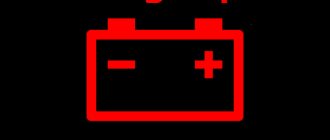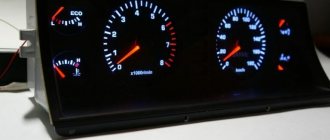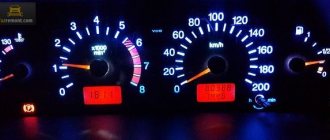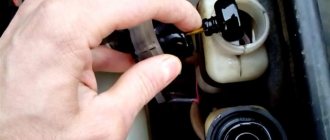Welcome, friends, to the DIY auto repair website. When you turn the ignition key, a number of warning lights come on on the dashboard. They signal that the system is working properly and the engine is ready to start.
The battery charging light is on
One of these indicators has an image of a battery. When you turn on the ignition, it starts to light up, and after starting the engine, it goes out.
This indicates that the battery is charging. But what if this does not happen? Why does the battery charging light stay on even after starting?
A little theory: scheme of work
To solve the existing problem, you must understand the essence of the interaction between the vehicle generator and the power source (battery).
While driving, the battery is in constant charging mode with a voltage of 13.6-14.2 Volts. As engine speed increases, the voltage at the generator output increases. But this is unacceptable.
To limit the voltage, a small relay regulator is inserted into the rotor excitation circuit. Its task is to reduce the current to a normal level (even with a significant increase in the speed).
The result is maintaining the battery charge voltage at a stable level. If the battery light is on, this indicates a lack of charging from the generator.
How does the scheme work? After turning on the ignition, voltage through fuse No. 10 (for VAZ-2107) is supplied to the battery charge indicator lamp.
Next, the “+12V” voltage passes through a diode, a built-in relay-regulator (we mentioned it above), a brush, a slip ring and a winding.
As soon as the rotor speed increases, the phase voltage also increases. As a result, the voltage at the terminals of the battery warning light is equalized and it goes out. At the same time, the battery is charging.
Ways to troubleshoot battery problems
First of all, you need to check the battery charging while the engine is running. During normal charging, the voltage will be in the range of 13.6 - 14.2 Volts. If the charge is weak, the value will be below 12 Volts (the author of the video is VAZ 2101-2107 repair and maintenance).
To troubleshoot problems, you need to prepare instructions with a diagram of the electrical equipment of the VAZ 2110 car and the necessary tools:
- pliers;
- flat and Phillips screwdrivers;
- multimeter;
- 12 V indicator light;
- knife;
- sandpaper.
Checking the battery on a car
There are the following troubleshooting methods, which can be determined by how the battery light lights up and goes out:
- If the charge indicator on the dashboard does not light up, this indicates that the battery is low. The reason why the battery is not charging may be due to oxidized contacts. The contacts on the battery should be cleaned. If this does not help, you need to measure the voltage at terminal “30” of the generator. To do this, one probe must be connected to ground, and the second to terminal “30”. If the flowing current greatly exceeds the charge on the battery, it is necessary to clean the terminal on the generator. It is possible that the wire connecting the generator to the device needs to be replaced.
- If the voltmeter on the dashboard and the warning light show that there is a charge, but the battery is discharged. In this case, the charge at the terminals is within normal limits, and when the equipment is turned on, the charge arrow occupies the extreme left position. This indicates insufficient tension on the generator drive belt or damage to it.
- The battery may not charge due to a breakdown in one of the diodes, as well as a break in the starter winding. In this case, with the ignition off, use a multimeter to check the diodes and, if necessary, replace them.
- The battery is not charging, but the indicator does not light up and the charge sensor does not work. The reason is a blown fuse F10.
- If the ignition is on, all devices are working, the charging indicator does not light up, and there is no charge, then you need to check the generator. To do this, remove the wire from terminal “61” on the generator and connect it to the car body, which will act as a “minus”. A lit battery indicator indicates a problem in the excitation winding of the generator device. The reason may be poor contact at the connection point. In this case, you need to clean the contacts. If this does not fix the problem, it is possible that the cause is a burnt-out lamp.
- When you turn the key in the ignition, the battery charging light comes on, but when the engine starts, it does not go out. In this case, there is no charging or it may periodically disappear, this indicates that the battery is discharging. The reason is insufficient contact in the place where the instrument panel is connected. It is possible that they have oxidized and need to be cleaned.
- The relay regulator should also be checked. To do this, you need to apply voltage to the contacts from the battery. If it is 12 volts at the brushes, then the relay is working properly. Otherwise it should be replaced.
- If the electrolyte level is insufficient, add the required amount of distilled water.
- If the battery case is damaged or the service life has expired, it should be replaced.
Reasons why the battery charging light is on
In fact, there are many reasons why the battery light comes on and does not go out. These include:
- Loosening of the belt tension on the generator, its wear or damage;
- fuse blown or deterioration of contact quality in the connectors of the mounting block;
- breakdown of the relay regulator, diode bridge, additional diodes;
- the appearance of a break in the generator excitation circuit;
- decreased quality of contact at the battery terminals or generator output;
- generator brush wear;
- lack of high-quality contact of the ground wire.
What to do if the battery charging light is on?
First of all, get out of the car and, with the engine running, measure the voltage at the battery terminals (do not remove the clamps under any circumstances).
If charging is in progress, the voltage should be at 13.6-14.2 Volts. In the absence of charge, the voltage level will be much lower - about 12 Volts.
To fix the problem, prepare the following tools:
- twelve volt indicator light,
- two screwdrivers (flat and Phillips),
- multimeter,
- pliers,
- knife,
- Use sandpaper to clean contacts.
So let's get started:
1. The readings of the on-board voltmeter indicate the presence of a charge, the charge signal lamp on the dashboard does not light up, there are about 12 Volts at the battery terminals, and the battery itself is almost discharged.
In such a situation, clean the wire connections on the power source itself. If these measures are useless, measure the voltage level at terminal “30” of the generator itself.
Place one multimeter probe on this terminal, and the other on ground. If the voltage here is much higher than at the battery, then strip the thirtieth terminal. If necessary, replace the wire from the generator to the battery.
2. The voltmeter on the dashboard and the lamp show the presence of a charge, but the battery is discharged.
The voltage on the battery is normal (about 14 Volts). Turning on a load (for example, headlights) causes the charge arrow to shift to the extreme left position.
The main reason is weak belt tension on the generator pulley (tension the belt, and if it is damaged, replace it).
This problem can also be caused by a breakdown of one of the diodes, as well as a break in the stator phase winding. Turn off the ignition and check the diodes with a multimeter. In case of breakdown, replace them.
Check the generator brushes. To do this, take them out and measure the length. If it is less than five millimeters, then it is better to replace the brushes.
3. When you turn the key in the ignition, the charge warning lamp does not light up, the charge sensor does not work, and there is no charge on the battery. The reason is a blown fuse.
Its designation is F10, rating is 10 Amperes. If installing a new fuse does not produce results, then the reason must be sought in the ignition relay or the lock itself.
4. After turning on the ignition, there is no charge, all devices work, the control warning lamp does not light up.
The check is simple - remove the wiring from terminal “sixty-one” of the generator and connect it directly to the “minus” (car body). If the light comes on, then the cause of the problem is the generator field winding.
The second option is bad contact in the connector. If after cleaning there is no result, then there is a risk of the lamp itself burning out.
5. When you turn the key in the ignition switch, the charge lamp lights up, and after starting it continues to light up. In this case, there is no charging or appears periodically. The reason is insufficient contact of the wire at the connector with the dashboard (it may oxidize).
Finally, check the relay regulator. To do this, apply voltage from the battery to its contacts. If there is 12 volts on the brushes, then the relay is working properly. If not, the device must be replaced.
Causes
There are only two reasons why the battery charging indicator light may be on:
- The VAZ 2110 battery lamp should light up when we turn on the ignition, and go out when the engine starts
- If this does not happen (does not go out), then the battery is not charging
- If, on the contrary, the light does not light up even when you start the engine, this may mean that the battery is completely dead
The instructions say that the battery usually runs out for two main reasons:
- The battery itself has failed, so it won't hold a charge.
- Or it does not receive recharging from the generator, although it itself provides power to the car’s network
Principle of operation
First you need to understand how the electrical circuit associated with the light bulb works:
- The generator, as we know, has a mixed excitation system
- This means that the rotor in it is magnetized, but for excitation it is necessary to apply current to the stator
- After the generator has been excited, it reaches operating speed, and then an induced current appears in the rotor winding; it is removed through slip rings by carbon brushes, which play the role of a collector (collector) in electric motors
- The current, after exiting the brushes, is sent to the diode bridge, the battery must be charged with direct current, the diode bridge serves precisely for this
- From the bridge, the electric current branches to the battery terminal and to the relay
- The relay has its own name, in scientific language so to speak RS-702, it is a relay for the battery charge indicator light
- The principle of operation of the relay is known to everyone: the voltage in it is supplied to the coil, a steel core is installed inside it
- Under the influence of an electromagnetic field, the core attracts the plate to itself, which opens the contacts in another circuit
- Our control light is located in this circuit.
- While the contacts are closed, the light is on, then goes out
VAZ 2110 battery light is on
Photo of the instrument panel of a VAZ 2110 car. The battery lamp is third from the left in the bottom row.
It is possible, for example, a loss of current when the car is turned off, or increased consumption of on-board electronics during a trip. And even under normal discharge conditions, the generator may fail and will not replenish the battery charge due to a malfunction. If when starting the VAZ 2110 the battery lamp on the dashboard lights up . then the latter option takes place.
But why exactly the generator does not supply voltage is quite difficult to immediately determine. The most obvious scenario is that the belt is loose and the generator simply does not reach the required speed for operation. Then you just need to tighten the belt and monitor the behavior of the light bulb. If even after this the battery does not charge, the voltage regulator may be the culprit.
Reasons for burning a light bulb
It's time to move directly to the reasons themselves, in other words, to making a diagnosis:
- First, we determine whether the VAZ 2110 battery light is constantly on or is it just blinking
- There is also an old-fashioned method that is strictly forbidden to be used on injection engines.
- The method is as follows - disconnect the negative terminal from the battery when the engine is running, after which the engine should continue to work further
- If the engine stalls, this indicates that the reason most likely lies in the electric generator
- Do not rush to remove the generator itself; first, you need to unscrew and check the brush assembly with the relay regulator (this is done even without removing the generator from the car)
- Inspect the condition of the brushes, maybe they are stuck, worn out or have defects, then it is better to replace them
- Then remove and disassemble to check its diode bridge
- The diode bridge, as a rule, becomes the cause of malfunction more often than other parts
- It is practically impossible to repair it with your own hands, so only replacement
- However, before replacing, you need to check if there is any burnout or short circuit.
- Therefore, in addition to everything else, we check the stator winding and rotor winding for breaks or short circuits
- All damaged, defective parts will need to be replaced
- When the motor continues to work after removing the terminal, as if nothing had happened, then the reason turns out to be not in the generator, the light is on because the electrical circuit does not open, this means that the fault lies in the relay, or the relay is not receiving voltage
- If in our case the reason was the first, then replacing the relay will solve everything
- If the second, then perhaps the problem is in the oxidation of the contact that comes out of the generator (see VAZ 2110 generator repair: we do everything ourselves), everything can be solved by cleaning this contact
- However, if we have an injection engine, then we need to disconnect the positive wire from the generator terminal, then connect a voltmeter to it
- The voltage supplied by the generator should be about 14.2 volts
- If the output voltage is less, then you need to remove the electric generator, disassemble it and clean its connections with sandpaper
- In addition, after checking the battery warning light relay, it is necessary to test the relay-regulator for malfunction
- In principle, it is the first on the list of reasons, and it is worth starting the check with it
- The relay regulator cannot be repaired, but must be immediately replaced
We draw a conclusion
By the way, the cost of repairing an electric generator, as a rule, comes at a considerable cost, due to the fact that its components are quite expensive. Therefore, before you start disassembling it, you need to think about what could have preceded this malfunction, since it, like all others, could not arise on its own:
- Remember - perhaps the car drove into a puddle at full speed
- And after that, water got into the electric generator, maybe it simply shorted out, then the car will start, but it only runs on battery power
- And if the light does not light up, but flashes or blinks, lights up at low engine speeds, then it is worth checking the tension of the drive belt, and tighten it if necessary
- Since the minimum engine speed at which the generator begins to produce electric current starts at 1500, the gear ratio from the crankshaft pulley to the generator drive belt is 1:2
The battery light is on - what does it mean?
There can be only one reason why the battery warning light comes on while the engine is running - there is no voltage supply from the generator or its value is insufficient.
The main malfunctions that lead to this:
- Lack of quality contact at the battery terminals.
- Damage to the alternator belt or loose tension.
- There is no negative contact with ground.
- An open circuit in the rotor excitation circuit or worn brushes in the generator.
- Failures of the diode bridge are usually accompanied by a dim lighting of the battery light on the dashboard.
- Fuse failure.
- Malfunction of the relay regulator.
Before you start troubleshooting, pay attention to why the lamp is on. If there is no voltage supplied to the battery at all, then the lamp lights up correctly. In another situation, the operation of the signal indicator while charging is present significantly complicates the problem.
First of all, determine whether there is voltage on the battery. To do this, take a voltmeter (multimeter), start the engine and measure the required characteristic at the battery terminals.
If everything is in good condition, you will see readings in the range from 13.6 to 14.2 V. In this case, the battery is charging properly. If the results obtained differ significantly from normal, then there is some kind of breakdown in the system.
A few words about how the battery-generator tandem works
Everyone, even a novice driver, knows that the battery interacts with the generator. After starting the engine, the battery goes into constant charging mode. After the engine speed increases, the voltage at the generator output also increases, which is not a “hum”.
In order to prevent the above described, a small relay-regulator is installed in the rotor excitation circuit, the task of which is to reduce the current to the optimal level, regardless of the engine speed. As a result, the voltage is maintained at the required level. The battery light comes on when there is no charging from the generator.
So, let's simulate the situation. You started the engine, but the battery light did not go out. What's the matter?
- Faulty relay-regulator, diode bridge;
- Poor tension of the generator belt, critical wear or belt slippage. Wear (play) of the generator bearing;
- Blown fuse or poor contact;
- Poor contact at the battery terminals, at the generator terminal or at the ground wire;
- Open circuit of the generator excitation circuit, serious wear of the generator brushes or brush holders;
- Wearing out the ignition switch is an option, but in this case several lights will light up at once.
Poor contact at battery terminals
Check the condition of the battery terminals and battery contact wires.
It is not uncommon for oxidation to occur in these places and the contact to weaken significantly. When the lamp comes on and there is charging, this could be the cause. In this case, the generator operates normally, voltage is supplied to the battery, but weakens due to insufficient contact. As a result, the warning light on the dashboard comes on. As a rule, the indication lights up dimly.
To fix the problem, you need to clean the terminals and contact pins. Additionally, treat these elements with a water-repellent agent.
Reasons why the battery charge lamp is on
When the power supply is in good condition, the battery warning lamp on the dashboard lights up only when the engine starts, and after one or two seconds it goes out. If this does not happen, or, for example, the icon is activated when the engine is idling or while driving, this is a sign of a malfunction, and you need to look for the reason why the battery warning light is on. So, the causes of this malfunction may be problems with the following units.
Generator
Most often, the battery light comes on if the generator does not transfer energy to the battery after starting the engine. This happens when the following problems occur:
- Loosening the belt tension. Or a critical situation - its breakdown. In this case, the belt will slip along the pulley, due to which the generator pulley will not rotate at the required angular speed and, accordingly, generate electricity at a low voltage, insufficient for normal battery recharging. Another option for belt slippage is contamination of its inner surface and/or the surface of the generator pulley. In such situations, during the cold season, a whistle appears from under the hood.
- Brush wear. Over time, generator brushes wear out naturally, causing the generator to produce electricity at low voltage.
- Problems with the voltage regulator relay. The task of this unit is to limit the voltage transmitted from the generator to the battery. If the specified regulator fails, then usually the voltage is not transmitted to the battery at all, as a result of which the battery lamp on the panel lights up.
- Diode bridge. Its function is to convert the alternating current produced by the generator into direct current. Accordingly, if it fails, the generator will not charge the battery.
- Faulty generator pulley bearings. So, with significant wear (or with a very strong belt tension), significant bearing play or jamming may occur. This usually results in belt slippage with the consequences described above.
Battery
The battery icon on the panel lights up when the battery simply cannot accept a charge. The first reason for this is the old age of the battery or its partial failure. Alternatively, there is a low level of electrolyte in it. The second reason is oxidation of the terminals and contacts suitable for it or contamination of surfaces.
Signal lamp
On many domestic cars, for example, VAZ 2109, VAZ 2110, VAZ 2114, VAZ 2115, an old type lamp with a filament is installed as a battery warning lamp. On these models, it is possible to change this lamp when dismantling the instrument panel if it fails.
However, some car enthusiasts, due to inexperience or ignorance, install an LED lamp instead of an incandescent lamp. This leads to the fact that after starting the engine and idling, the lamp (at a voltage of just over 12 Volts) continues to burn. However, if you force the engine speed up to about 2000 rpm, the battery light goes out.
Wiring
Often the cause of incorrect operation of the battery lamp is damaged wiring. For example, when a lamp burns at half intensity or even dimmer, and in a variety of situations. Often the wiring is to blame. For example, a wire going from the battery to the generator. In particular, there are cases when, with a damaged wire (fracture, damage to the insulation), the lamp begins to glow a little even with a slight load on the battery.
Similarly, the battery lamp may burn at half incandescence due to poor contact on the voltage regulator (the so-called “chocolate bar”). Poor contact may be due to corrosion or mechanical damage.
Diode bridge faults
The electrical circuit is designed to convert alternating voltage to direct voltage. If a breakdown of at least one of the diodes occurs, the functional unit ceases to perform its duties. The consequence of this is the supply of voltage that does not correspond to the required indicators.
The rectifier needs to be checked when the battery charging light is on, but there is charging.
You can determine the breakdown by using a multimeter. Take a tester and connect the red probe to the positive of the bridge, and the black one to one of the contacts marked AC.
The throughput voltage for diodes (silicon) ranges from 400 to 1000 mV. If the tester shows different values, then the bridge needs to be changed. Such a unit cannot be repaired.
Reasons why the battery charge lamp is on
When the power supply is in good condition, the battery warning lamp on the dashboard lights up only when the engine starts, and after one or two seconds it goes out. If this does not happen, or, for example, the icon is activated when the engine is idling or while driving, this is a sign of a malfunction, and you need to look for the reason why the battery warning light is on. So, the causes of this malfunction may be problems with the following units.
Generator
Most often, the battery light comes on if the generator does not transfer energy to the battery after starting the engine. This happens when the following problems occur:
- Loosening the belt tension. Or a critical situation - its breakdown. In this case, the belt will slip along the pulley, due to which the generator pulley will not rotate at the required angular speed and, accordingly, generate electricity at a low voltage, insufficient for normal battery recharging. Another option for belt slippage is contamination of its inner surface and/or the surface of the generator pulley. In such situations, during the cold season, a whistle appears from under the hood.
- Brush wear. Over time, generator brushes wear out naturally, causing the generator to produce electricity at low voltage.
- Problems with the voltage regulator relay. The task of this unit is to limit the voltage transmitted from the generator to the battery. If the specified regulator fails, then usually the voltage is not transmitted to the battery at all, as a result of which the battery lamp on the panel lights up.
- Diode bridge. Its function is to convert the alternating current produced by the generator into direct current. Accordingly, if it fails, the generator will not charge the battery.
- Faulty generator pulley bearings. So, with significant wear (or with a very strong belt tension), significant bearing play or jamming may occur. This usually results in belt slippage with the consequences described above.
Battery
The battery icon on the panel lights up when the battery simply cannot accept a charge. The first reason for this is the old age of the battery or its partial failure. Alternatively, there is a low level of electrolyte in it. The second reason is oxidation of the terminals and contacts suitable for it or contamination of surfaces.
Signal lamp
On many domestic cars, for example, VAZ 2109, VAZ 2110, VAZ 2114, VAZ 2115, an old type lamp with a filament is installed as a battery warning lamp. On these models, it is possible to change this lamp when dismantling the instrument panel if it fails.
However, some car enthusiasts, due to inexperience or ignorance, install an LED lamp instead of an incandescent lamp. This leads to the fact that after starting the engine and idling, the lamp (at a voltage of just over 12 Volts) continues to burn. However, if you force the engine speed up to about 2000 rpm, the battery light goes out.
Wiring
Often the cause of incorrect operation of the battery lamp is damaged wiring. For example, when a lamp burns at half intensity or even dimmer, and in a variety of situations. Often the wiring is to blame. For example, a wire going from the battery to the generator. In particular, there are cases when, with a damaged wire (fracture, damage to the insulation), the lamp begins to glow a little even with a slight load on the battery.
Similarly, the battery lamp may burn at half incandescence due to poor contact on the voltage regulator (the so-called “chocolate bar”). Poor contact may be due to corrosion or mechanical damage.
Fuse failure
The electrical circuit for charging the battery is protected by a fuse. This element is located in the vehicle’s mounting block and is marked as F10. However, before checking for a malfunction in this place, it is better to first read the vehicle’s operating instructions, in which you will find out the exact designation of the required element.
If the fuse fails, the battery is not charged at all. However, there are times when the warning light comes on, but there is charging.
You can check the element using a tester (the part is removed from the mounting block). If the multimeter shows that the fuse is bad, all you have to do is replace it.
All electrics of the VAZ 2110 have disappeared
21103 2000. Sometimes while driving the lights and the instrument panel would go out and go out for a short period of time, but the emergency lights would still work. About two months ago a bad ground was found at the negative terminal. It seems like it was decided by her. But it was not there.
At one point this week, almost everything went out - the lights (low, high, fog lights), computer, signal, heater, wipers, washer, turns and emergency lights, power windows. But all the other electrical items remained. The cigarette lighter and tape recorder are not a fact; they may have long been connected to a place other than the state. In total, the following worked: instrument lighting, warning lights for oil pressure, charging, etc., dimensions, stops, rear, fuel pump.
The engine started normally (if there was a gap in the starter on the battery) for two whole days, but on the third day, after being parked overnight in a strong wind, it refused to start. But twice in these two days everything returned, but not for long, the first time for half an hour, the second for an hour.
After parking for the night (mentioned above), the key refused to start, even the starter did not work. We started with a screwdriver, the engine started without problems at minus five, we warmed it up by eye, because the engine temperature indicator and the heater did not work.
Go. and, lo and behold, after three or four kilometers EVERYTHING turned on again. The car drove home like that horse - it ran on its own. I ran 200 km without problems, the only thing was that, so as not to provoke, I didn’t turn on the turns and didn’t turn off the lights (I didn’t touch the ignition key, because there were suspicions about it), and everything else was there - the neighbor, the heater on full, etc.
We arrived home, drove around the “place” for half a day, started the starter twenty times, blinked the distant lights with all the heat on - at least WHAT.
The next morning minus 18, BUT EVERYTHING IS NORMAL. We go to work and at 14.00 we try to warm up - EVERYTHING, NOTHING.
THE TOTAL RESULT is the lack of power supply to the CY along Sh3 due to the “burnt out” contacts of the nameless PINK and BROWN wiring connector on the way to Sh3.
Failure of the relay regulator
A malfunction of the relay regulator is another reason why the battery charging light comes on.
This node is responsible for turning on/off the signal indicator. The principle of operation of the device is as follows: when the ignition is turned on, current flows through its closed contacts, which comes from the battery and feeds the indicator signals. When the internal combustion engine starts, the generator starts working, which supplies the relay with already rectified voltage and the contacts of the unit open. At this time the light should go out.
You can check the part yourself. Disconnect both wires from it and short them together. Start the engine and look at the dashboard. If there is no indication, you need to change the relay.
Reasons why the generator is not charging
- Brush wear
The most common reason why the generator does not charge the battery. This is wear on the brushes. The carbon contacts that transmit voltage from the regulator relay to the rotor windings are erased and the contact disappears. With this malfunction, the warning lamp on the instrument panel stops lighting up.
That is, when the ignition is turned on, if everything is working properly, the charging control icon should light up. The engine starts and the lamp goes out. This means that the generator is running and charging the battery.
In case there is no contact on the brushes. The light does not light up when the ignition is turned on. You can make sure that the reason is in the contacts.
The wire that goes to the regulator relay must be shorted to ground. Turn on the ignition. The light should light up. This means that there is no contact between the brushes and the slip rings. Or there is a break in the rotor winding.
If the charging indicator lamp does not light up when the wire is shorted to the housing. This means the LED has burned out. Which lights up the charging icon. Or a broken wire. It is necessary to ring the circuit from the regulator relay to the instrument panel.
2. Malfunction of the relay regulator
How to check whether the generator is charging the battery if the regulator relay integrated circuit fails. Two faults are observed. The generator stops charging. Because the relay regulator does not supply voltage to the rotor winding. Or, on the contrary, the generator voltage increases with increasing speed. This exceeds the permissible voltage for the vehicle's electrical system. This may cause the battery to overcharge. Which will lead to destruction of the plates and short circuit of the battery. Excessive voltage will also lead to failure of the vehicle's electrical equipment.
Checking the regulator relay
The relay regulator can be checked. Using a power supply capable of smoothly changing the voltage from 10 to 20 volts.
The relay regulator is connected according to the following diagram:
When the voltage increases above 14.2 _+ 0.3 volts, the light should go out. If the voltage decreases, the light comes on. This means that the relay regulator is working
3. Low tension of the generator drive belt.
If there is any doubt that the generator is not charging, the first thing to check is the tension of the drive belt. Because the resulting magnetic fluxes create resistance to rotor rotation. When the generator starts up. A loose belt slips on the generator pulley. The rotor stops rotating. The generator does not produce voltage
If you don't immediately pay attention to the belt tension. Generator diagnostics will not give results
In fact, the fault will have to be found on a working generator. This malfunction is classified as curious. But they fall for it very often.
These are external signs of how to check whether the generator is charging the battery. If they were not enough to determine the malfunction. Next you need to remove the generator. Disassemble it and check its elements separately.
Useful tips
To prevent your car from having problems charging the battery, use the following tips:
- Don't ignore your car's dashboard signals. In this case, you will be able to solve the problem at the initial stage of its development.
- Inspect the alternator belt regularly. The correct operation of all electrical equipment on board directly depends on it. If there are any defects, replace it as soon as possible.
- Check the voltage from the generator to the battery. If you notice a discrepancy, diagnose the on-board network.
- Periodically pay attention to the condition of the battery terminals. If you notice oxidation, eliminate this defect. They can be treated with WD-40.
- Isolate the generator and battery from water to prevent short circuits. Leave engine washing to professionals.
- When repairing the battery charging circuit, do not use cheap spare parts.
To summarize, we note that the battery is the most important element in the car’s electrical network. Therefore, you should carry out timely maintenance of the charging circuit and, if necessary, change the necessary parts. In this case, you will ensure a proper system of work. In the article, we told you about the main malfunctions that can cause the battery charging lamp to light up and what to do about it. We hope our recommendations will help you in solving the problem at hand.
To post a reply you must log in or register.
Where to look for the reason?
- You should not immediately dismantle the generator, it is in vain. Carry out diagnostics in the brush compartment on the generator. If there are visual defects or sticking, replace with new ones and test the car. If the cause cannot be eliminated, proceed to the next step;
- Diode bridge:
it is not subject to partial replacement or maintenance, only complete replacement. At the same time, check to see if there is a burnout at the place where it is attached, as there may be a short to the winding in the rotor. See the article “How to check a diode bridge”; - Problems with the relay:
perhaps there is no current flowing to it due to oxidation of the contacts. It is necessary to carefully disconnect the contacts and clean them with fine sandpaper or a triangular file. Using a voltmeter, check the output voltage at the generator, first resetting the positive terminal. The standard voltage should be 14.2–14.3 V. If the voltage is less than normal, then it is necessary to disassemble the generator and look for a breakdown in the rotor and stator windings;
- Another common cause of a short circuit is water getting into the generator, for example, during a drive into a puddle. After this, the car is powered only by the battery;
- A poor-quality timing belt can also cause inconsistent battery charging due to slipping. This can be corrected by tensioning it using a pry bar and a spanner. Otherwise, replace the belt. Article on the topic “Which timing belts are better?”;
- Fuses
responsible for the operation of the dashboard. To do this, you need to look at the fuse number in the operating instructions and change it to the appropriate one. If it's not in stock, be sure to purchase it.
Here, in fact, this is the end of the topic of why the VAZ 2110 battery light is on. All common causes are discussed, as well as ways to eliminate them. We hope that our recommendation article will help many drivers quickly find and fix problems, thereby extending the life of the vehicle. Let problems bother your car as little as possible. Good luck to you.
The charging lamp does not light up, search for reasons.
What should you do if the charging lamp does not light up when you turn on the ignition? How to quickly find a problem? All subsequent actions regarding the warning lamp do not apply to the VAZ 2101 (2103, 2106).
The first step is to determine the faulty location, that is, the generator or control lamp with wire is faulty. To quickly determine, you need to disconnect the thin wire from the generator that comes from the control lamp, connect it to the vehicle ground and turn on the ignition. If the lamp lights up, then the generator is faulty. Possible malfunctions
There may be a break in the generator winding, a malfunction of the voltage regulator, wear of the armature brushes or slip rings, and so on.
Checking the serviceability of the lamp and wire.
If the charge control lamp does not light up, you need to check the serviceability of the lamp and wire. For this check, you do not need to remove the instrument panel and pull out the lamp to examine the integrity of the filament. It is enough to connect one probe of the multimeter, in voltmeter mode, to the disconnected wire, and the second to the car body. Instead of a multimeter, you can use a test lamp with a power of no more than 1 W.
If the circuit is working properly, the multimeter will show the battery voltage, and the control lamp will glow at half-glow. In this case, the charge control lamp burned out. If the voltmeter reading differs greatly from the battery voltage, then there may be an open circuit in the circuit from the control lamp to the generator.
If we consider a similar situation for the VAZ-2106 (2101, 2103), then the situation here is somewhat different. It's all about the presence of the P-702 relay, which supplies power to the battery charge monitoring lamp and is located under the hood on the right wing. In this case, checking the circuit and the serviceability of the lamp itself is enough to connect the supply wire to the relay with the wire from the control paw. If everything is in order, the lamp will light up. To check the lamp relay, you need to measure the voltage on the yellow wire with the engine running. The voltage must be at least 6 V. If the voltage is lower, then the generator is faulty, otherwise the relay.
“The battery light is on, I give it gas, it goes out” - a classic symptom with a simple solution
Let's get straight to the point. Let's consider two situations.
First
: the emergency battery charge lamp fades smoothly with increasing engine speed.
In this case, the on-board computer (or a multimeter at the terminals) shows an increase in the charge voltage. When you release the gas pedal, the voltage readings drop again and the lamp lights up again.
This is a typical sign of failure of either the rectifier (“diode bridge”) or fatigue of the brush assembly. In 90% of cases, the described picture fits into these two diagnoses.
Also, there is a second scenario.
When the battery charge lamp is on, but goes out with gas until next time.
But here the generator excitation circuit is usually to blame. If you look at the generator, you will see that in addition to the thick “plus”, there is a thin wire going to it. It comes from the dashboard, passing through that same red light, and when it oxidizes or breaks, a symptom of “one-time undercharging” occurs.
Treatment: look for a break in this wiring. However, it often happens that undercharging begins to manifest itself sporadically. At first, the lamp begins to burn irregularly and weakly, and the charging voltage, although it does not disappear completely, floats. This situation progresses every day until it turns into a regular problem when there is not enough charge to properly power the battery. In this case, you need to check the contacts on the terminals of the copper windings of the generator stator.
And one last piece of advice from experience.
Very often, with any problem with the battery charge, they begin to blame the battery itself, namely its capacity. They say that the battery capacity does not correspond to the original factory one - hence all the problems. Various articles on the Internet have repeatedly proven in detail (with formulas and figures) that such “advice” is complete nonsense and has no connection with reality. The capacity of the battery does not at all affect the efficiency of its charging in a working car.
Well, it never hurts to carry out battery maintenance. I described in detail how to do this (even on supposedly maintenance-free batteries) here.
The battery light is on on the instrument panel of the VAZ 2110, reasons and how to fix it
Welcome, friends, to the DIY auto repair website.
When you turn the ignition key, a number of warning lights come on on the dashboard. They signal that the system is working properly and the engine is ready to start. One of these indicators has an image of a battery. When you turn on the ignition, it starts to light up, and after starting the engine, it goes out.
This indicates that the battery is charging. But what if this does not happen? Why does the battery charging light stay on even after starting?
